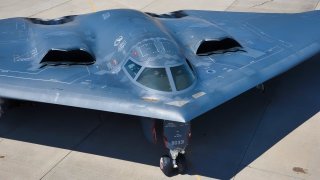Sad Fact: The U.S. Air Force Has Only 19 B-2 Spirit Stealth Bombers
Despite its aging status, the B-2 remains a critical asset in the U.S. nuclear triad, thanks to its low observability and long range. With only 19 units in service, the B-2’s role is increasingly vital as tensions with China and Russia escalate.
Summary and Key Points: Despite its aging status, the B-2 remains a critical asset in the U.S. nuclear triad, thanks to its low observability and long range.

-With only 19 units in service, the B-2’s role is increasingly vital as tensions with China and Russia escalate.
B-2 Bomber: The Stealth Legend with an Unfixable Problem
The U.S. Air Force’s legendary B-2 Spirit stealth bomber showed its worth during the world’s largest naval exercise, which took place around Hawaii this month.
During the U.S.-led Rim of the Pacific exercises, or RIMPAC 2024, a B-2 was used to take out a large surface ship in an exercise for the first time. Using an inexpensive guided bomb, the aircraft was able to “hit and sink” the retired USS Tarawa. The drill, called QUICKSINK, could demonstrate a “a low-cost method of achieving torpedo-like seaworthy kills from the air at a much higher pace and over a much larger area than covered by a lumbering submarine,” according to the Air Force Research Lab.
The B-2 is one of the most versatile aircrafts in the U.S. military, but only 19 remain in service.
The Enduring Legacy of the B-2 Spirit Stealth Bomber
The B-2 is aging, but the stealth bomber continues to play a critical role in America’s nuclear triad. Capable of delivering nuclear and conventional weapons, the multi-role bomber deters U.S. adversaries by its mere existence.
The Spirit is the product of stealth technology’s refinement during the early days of the Cold War, when aircraft engineers were uncovering methods to avoid interceptors and missiles. The military wanted an aircraft capable of flying nearly undetected by deflecting or absorbing radar signals. Lockheed Martin and Northrop Grumman were selected to develop prototypes incorporating this technology, leading to the F-117 and B-2, respectively.
The B-2’s renowned flying wing design makes it virtually invisible to radar. As detailed by the Air Force, the bomber’s top advantage is its low observability, which provides the platform with greater freedom of action at high altitudes. Northrop Grumman created a radar-absorbent coating called alternate high-frequency material to preserve stealth characteristics while minimizing maintenance. Its unrefueled range is roughly 6,000 nautical miles.

The Spirit first flew in the 1990s and achieved full operational capability in late 2003.
The Spirit can carry up to 40,000 pounds of weaponry in two weapons bays at the center of the aircraft. Both weapons bays feature a rotary launcher in addition to two bomb-rack assemblies. A generic weapons interface system was added to the bomber as part of the Block 30 upgrade, which allows the B-2 to attack up to four different types of targets on one mission.
Why the Small Fleet Size for B-2?
When the B-2 was designed, the Air Force was gearing up for a longer arms race with the Soviet Union. The collapse of the USSR, and the shift to the War on Terror that followed, certainly altered the Pentagon’s priorities. Initially, the Air Force intended to procure 75 B-2 bombers. The Bush administration cut this number drastically in the early 1990s. A total of 21 were produced, but not before the cost per bomber soared to roughly $800 million-900 million.
While a larger B-2 fleet probably would not have been critical to the U.S. military’s missions in Iraq and Afghanistan, the renewed competition with Russia and China changes priorities. The Air Force’s bomber fleet is small, and its upcoming B-21 Raider is still under development. Regardless of how capable the service’s remaining 19 Spirit bombers are, Beijing’s expansive naval force could dominate if a kinetic conflict were to erupt.

About the Author: Maya Carlin, Defense Expert
Maya Carlin, National Security Writer with The National Interest, is an analyst with the Center for Security Policy and a former Anna Sobol Levy Fellow at IDC Herzliya in Israel. She has by-lines in many publications, including The National Interest, Jerusalem Post, and Times of Israel. You can follow her on Twitter: @MayaCarlin.
All images are Creative Commons and/or Shutterstock.


